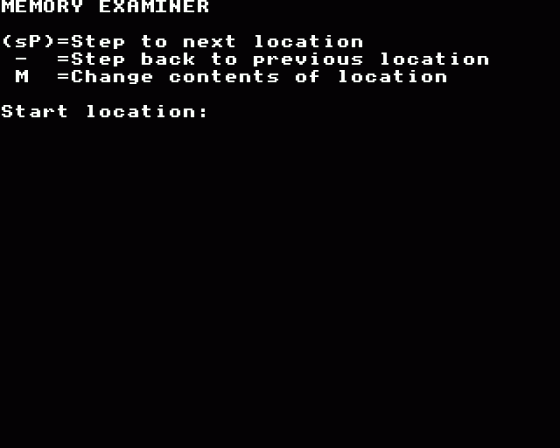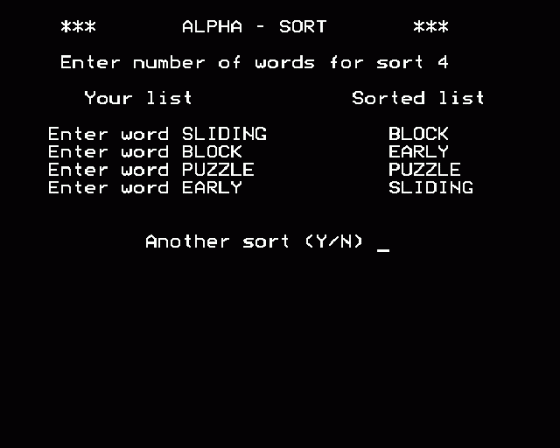
EUG PD
 1st January 2006
1st January 2006
Categories: Review: Software
Author: Dave E
Publisher: Acorn Programs
Machine: BBC/Electron
Published in EUG #66
The Eighties were a wondrous time, or so I'm told by people who actually remember them. Acorn Programs debuted at the end of 1983, which would make me about four years old and still unable to read when the magazine premiered. Despite this, I can still remember the rack of magazines in the paper shop on Green Lane, where I used to buy football chews at 1p each and which never seemed to have more than one copy of anything! I can just picture Acorn Programs nestled in with Look-In, Popular Computing Weekly, Crash, C&VG and Smash Hits...
Or, then again, perhaps Acorn Programs never reached up north, as practically everything had to be ordered in - and the proprietor was ruthless in sending back even the magazines his shoppers had promised to come in and pay for. I remember boycotting the shop entirely after he sent back issue three of my reserved Red Dwarf Smegazine because I was a day late coming in to get it, even though I'd shopped there for ten years or so by that juncture. However, I digress. Whether or not I could have got Acorn Programs at the time or not, all this cheerful reminiscing leads me nicely into a review of the unofficial companion disc to its very first issue.
The very first thing I should mention is, of course, that I personally put together the menu system which fronts the disc because the programs were only ever supplied in the magazine itself, to be typed in by the user. To do this, I simply made modifications to the Electron User logo on their menu program and replicated the Acorn Programs one. The menu system is therefore instantly familiar to anyone who has experience of the Electron User program discs. Hey, if it ain't broke, why try to fix it, that's what I say!
With 25 programs on the disc, you might think initially that you're spoiled for choice. However, the quality of an individual program, as with all magazine listings, varies immensely. Now, in no other publication do you get such stark contrast between submissions as in Acorn Programs. Some of the programs are, to be frank, dire. I also believe this very first disc suffers more than most in that, in their desperation to 'wow' a potential readership with quantity, EEC Publications might have actually churned out the programs themselves.
Let me take a few examples: Binary - a program that quizzes you on what decimal numbers are in binary code, but keeps no record of your score and simply loops eternally asking the same 'random' numbers; Memory Probe - type in a location in hex and your computer tells you what number is stored in that location; Sketcher - draw lines on the screen; Guess - guess the number between 1 and 100 and Duel - completely text-based, you wait ten seconds then draw an imaginary pistol from an imaginary holster and press SPACE to shoot the computer before it gets you. Listing the code for any of these programs produces listings so basic that I find it difficult to believe any originally took more than a hour to program.
At the time, one might argue what would you expect for 95p, and that's a fairly valid point. My point is more that some programs were originally considered marvellous in their day (Amx Art, for example), but now seem shoddy compared to today's computer programs. These programs seemed shoddy even back then - they now appear so dated as to be almost laughable. You are simply not going to enjoy converting decimals to binary for no reward, getting to see the contents of random memory locations or banging SPACE when you see an asterisk!
To save plodding on through all of these "bad 'uns" in turn therefore, let me instead focus on what is good on the disc. Firstly, Jungle Maze, a small maze-game in 8x8 CHR$ blocks in Mode 5. You guide around a little man, collecting items (which look rather like postcards) and avoiding a gorilla. Secondly, the Map Game, which draws a Teletext style map of England on your screen and then invites you to find places of interest. Both have some nice graphics and, at least offer some challenge. However, even with these the use of the cursor keys for control is a mistake as these are so near the BREAK key on the Electron.
I'll also give a passing nod to Invasion and Bar Maze. They are pretty cumbersome, due to impossibility in the case of the former and the lack of keyboard flushing in the latter, but at least they can be played with a little perseverence. All of the rest of the programs are complete pants. And not only are they pants, I also found that attempting to play quite a few of them produced errors which ended the program! BULL & COW gave up the ghost with "Array at line 950", Word Processor, as soon as I began typing text into it, gave me "No such variable at line 850" and Colour Logic was illogical, telling me that two of my colours were correct for both all-five-places-green, all-five-places-red and all-five-places-blue guesses. That, by my reckoning, adds up to six, not five!
There's also a distinct lack of knowing "what to do" with some of the utilities. Not all of them have instructions - Colour Logic for example has an incredibly annoying input system whereby, after you've finished your input, you press RETURN if you want to change it! Of course, this isn't written anywhere apart from the magazine so you end up wondering why you never move off your first guess. It turns out that the key 'N' is what you must tap to conclude your selection. What a barmy way of going on!
And another thing. None of these programs really need Mode 7, yet it is used in some of them, forcing the Electron (unless you're lucky enough to have a Mode 7 Display Unit, of course) to display very odd effects on the screen. The magazine itself was, regrettably, content with contributors stating which computer they wrote a piece of software for - the program was then published as "a listing for the BBC" or "a listing for the Electron" accordingly. The programs really are so simple, would it have been too much to ask that they worked on both machines without readers having to modify delay times and modes to suit? Apparently the answer to that question, to EEC Publications, was yes.
I know there are two schools of thought with regard to publishing type-ins and that some believe the programs should appear completely "as is" (bugs and all) whilst others believe that an obvious error should be corrected for a disc version. I believe that most people would much rather not have anything they download 'hang' on them, and would suggest that Acorn Electron World do get their original version of this disc and sort out the errors I have identified. Although whether it's even worth it given the quality (or lack of it) of these listings, I'm not entirely sure.
It's strange how things transpire on the 8-bit BBC and Electron front. Practically no-one either heard or remembered this magazine until a few issues of it came up on eBay in July 2001. Now, courtesy of www.acornmags.com, at least four issues are available to download in full and for free - whilst to view one time family names Electron User and The Micro User in full, you still have to be pick up copies second hand. Yet, despite the rarity of the publication and my obvious delight at it being made available, I cannot even feign an interest in the majority of the programs contained within its pages.



















